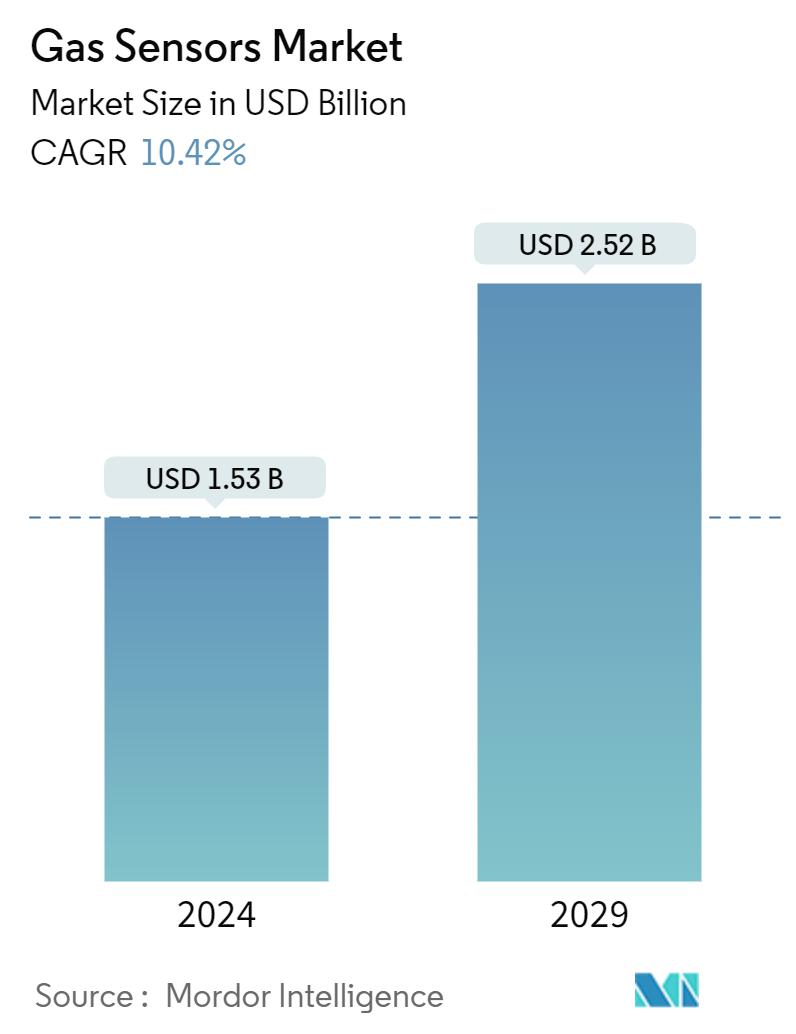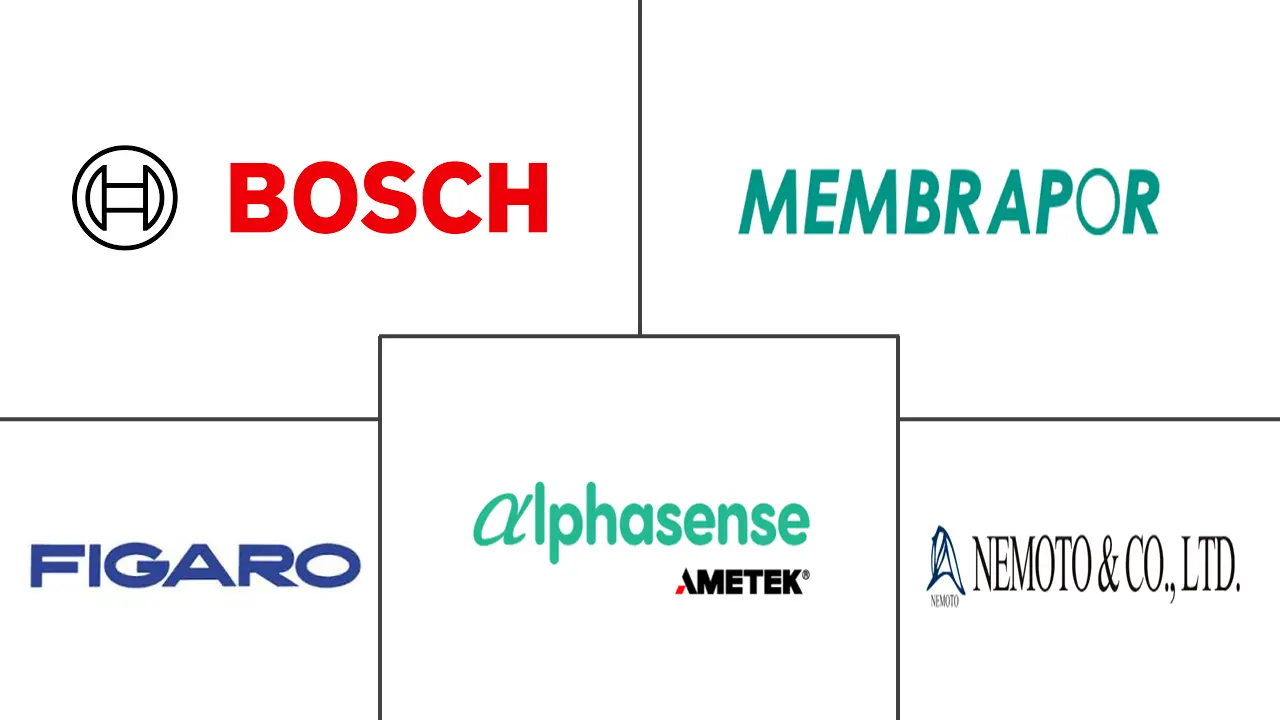Market Size of Gas Sensors Industry

| Study Period | 2019 - 2029 |
| Market Size (2024) | USD 1.53 Billion |
| Market Size (2029) | USD 2.52 Billion |
| CAGR (2024 - 2029) | 10.42 % |
| Fastest Growing Market | Asia Pacific |
| Largest Market | Asia Pacific |
| Market Concentration | Low |
Major Players
*Disclaimer: Major Players sorted in no particular order |
Gas Sensors Market Analysis
The Gas Sensors Market size is estimated at USD 1.53 billion in 2024, and is expected to reach USD 2.52 billion by 2029, growing at a CAGR of 10.42% during the forecast period (2024-2029).
- In smart cities, gas sensors find applications in environmental monitoring, including air quality checks at weather stations, public areas, and within building automation systems. This widespread adoption is expected to drive the market's growth through the forecast period.
- Additionally, heating, ventilation, and air conditioning (HVAC) systems are integral to buildings, monitoring environments and regulating gas concentrations. This dual functionality has spurred significant demand, further fueling market growth.
- Gas detection is paramount in the global oil and gas sector. This industry's offshore drilling and exploration activities produce a spectrum of hazardous, flammable, and toxic gases. While some gases are benign in small quantities, they can deplete oxygen in high concentrations, leading to severe risks like suffocation. As oil production is projected to rise, so is the demand for gas sensors. These sensors are crucial for swiftly identifying gas leaks from equipment, pipelines, and storage tanks.
- Increasing awareness of workplace hazards related to toxic and hazardous gases is propelling the adoption of gas sensors, especially in sectors like oil and gas, chemicals, petrochemicals, metals, and mining. Given the potential risks, chemical industries often rely on gas sensors to trigger emergency systems when gas concentrations exceed safe limits.
- Production costs for gas sensors have increased, primarily due to technological advancements. Many sensors now incorporate cutting-edge technologies like microelectromechanical systems (MEMS) or nanotech, which, while enhancing performance, also complicate the fabrication process, thereby increasing costs. Developing these advanced sensor technologies necessitates substantial investments in research and development, further adding to the cost structure. While established players have adapted to these changes, newcomers and mid-tier manufacturers face significant hurdles.
- The gas sensors market faced notable disruptions due to the Russia-Ukraine conflict and subsequent economic slowdown. Rising inflation and interest rates curtailed consumer spending, dampening the demand for gas sensors. The trade tensions between the United States and China exacerbated global supply chain disruptions. Notably, the United States' stringent controls on semiconductor manufacturing equipment exports to China have hampered production in China's consumer electronics and automotive sectors.
Gas Sensors Industry Segmentation
Gas sensors are electronic devices that can detect and identify the presence and concentration of various hazardous gases and vapors, such as toxic or explosive gases, volatile organic compounds (VOCs), humidity, and odors.
The gas sensors market is segmented by type (oxygen, carbon monoxide (CO), carbon dioxide (CO2), nitrogen oxide, hydrocarbon, other types), technology (electrochemical, photoionization detectors (PID), solid-state/metal oxide semiconductor, catalytic, infrared, semiconductor), application (medical, building automation, industrial, food and beverage, automotive, transportation and logistics, and other applications), and geography (North America [United States, Canada], Europe [Germany, United Kingdom, France, Rest of Europe], Asia Pacific [China, Japan, India, Rest of Asia Pacific], Latin America [Brazil, Argentina, Mexico, Rest of Latin America], Middle East, and Africa [United Arab Emirates, Saudi Arabia, Rest of the Middle East and Africa]). The market sizes and forecasts are provided in terms of value (USD) for all the above segments.
| By Type | |
| Oxygen | |
| Carbon Monoxide (CO) | |
| Carbon Dioxide (CO2) | |
| Nitrogen Oxide | |
| Hydrocarbon | |
| Other Types |
| By Technology | |
| Electrochemical | |
| Photoionization Detectors (PID) | |
| Solid State/Metal Oxide Semiconductor | |
| Catalytic | |
| Infrared | |
| Semiconductor |
| By Application | |
| Medical | |
| Building Automation | |
| Industrial | |
| Food and Beverages | |
| Automotive | |
| Transportation and Logistics | |
| Other Applications |
| By Geography*** | |||||
| |||||
| |||||
| |||||
| Australia and New Zealand | |||||
| |||||
|
Gas Sensors Market Size Summary
The gas sensors market is poised for significant growth, driven by their increasing application in smart cities for environmental monitoring and in HVAC systems for regulating gas concentrations. The demand for gas sensors is further bolstered by their critical role in the oil and gas sector, where they are essential for detecting hazardous gases during offshore drilling and exploration activities. The rising awareness of workplace hazards in industries such as chemicals, petrochemicals, metals, and mining is also propelling the adoption of gas sensors. However, the market faces challenges due to rising production costs linked to technological advancements, such as the integration of MEMS and nanotech, which require substantial investments in research and development. Geopolitical tensions and economic factors, including the Russia-Ukraine conflict and trade disputes between the United States and China, have disrupted global supply chains, impacting market dynamics.
The market is characterized by a fragmented landscape with numerous players offering technologically differentiated products. Companies are employing competitive pricing strategies to capture market share, with key players like Membrapor AG, AlphaSense Inc., Nemoto & Co. Ltd, Figaro Engineering Inc., and Robert Bosch GmbH leading the charge. Recent developments include Figaro Engineering's expansion in Europe and MEMBRAPOR AG's enhancement of its NO2/CA-2 sensor. Innovations such as NET's thermal conductivity sensor for hydrogen detection highlight the ongoing advancements in sensor technology. The growing focus on alternative energy sources, like hydrogen, and the need for stringent safety measures in industries underscore the critical importance of gas sensors in ensuring safety and compliance with regulatory standards.
Gas Sensors Market Size - Table of Contents
-
1. MARKET INSIGHTS
-
1.1 Market Overview
-
1.2 Industry Attractiveness - Porter's Five Forces Analysis
-
1.2.1 Bargaining Power of Suppliers
-
1.2.2 Bargaining Power of Buyers
-
1.2.3 Threat of New Entrants
-
1.2.4 Threat of Substitutes
-
1.2.5 Intensity of Competitive Rivalry
-
-
1.3 Industry Value Chain Analysis
-
-
2. MARKET SEGMENTATION
-
2.1 By Type
-
2.1.1 Oxygen
-
2.1.2 Carbon Monoxide (CO)
-
2.1.3 Carbon Dioxide (CO2)
-
2.1.4 Nitrogen Oxide
-
2.1.5 Hydrocarbon
-
2.1.6 Other Types
-
-
2.2 By Technology
-
2.2.1 Electrochemical
-
2.2.2 Photoionization Detectors (PID)
-
2.2.3 Solid State/Metal Oxide Semiconductor
-
2.2.4 Catalytic
-
2.2.5 Infrared
-
2.2.6 Semiconductor
-
-
2.3 By Application
-
2.3.1 Medical
-
2.3.2 Building Automation
-
2.3.3 Industrial
-
2.3.4 Food and Beverages
-
2.3.5 Automotive
-
2.3.6 Transportation and Logistics
-
2.3.7 Other Applications
-
-
2.4 By Geography***
-
2.4.1 North America
-
2.4.1.1 United States
-
2.4.1.2 Canada
-
-
2.4.2 Europe
-
2.4.2.1 Germany
-
2.4.2.2 United Kingdom
-
2.4.2.3 France
-
-
2.4.3 Asia
-
2.4.3.1 China
-
2.4.3.2 Japan
-
2.4.3.3 India
-
-
2.4.4 Australia and New Zealand
-
2.4.5 Latin America
-
2.4.5.1 Brazil
-
2.4.5.2 Argentina
-
2.4.5.3 Mexico
-
-
2.4.6 Middle East and Africa
-
2.4.6.1 United Arab Emirates
-
2.4.6.2 Saudi Arabia
-
-
-
Gas Sensors Market Size FAQs
How big is the Gas Sensors Market?
The Gas Sensors Market size is expected to reach USD 1.53 billion in 2024 and grow at a CAGR of 10.42% to reach USD 2.52 billion by 2029.
What is the current Gas Sensors Market size?
In 2024, the Gas Sensors Market size is expected to reach USD 1.53 billion.

